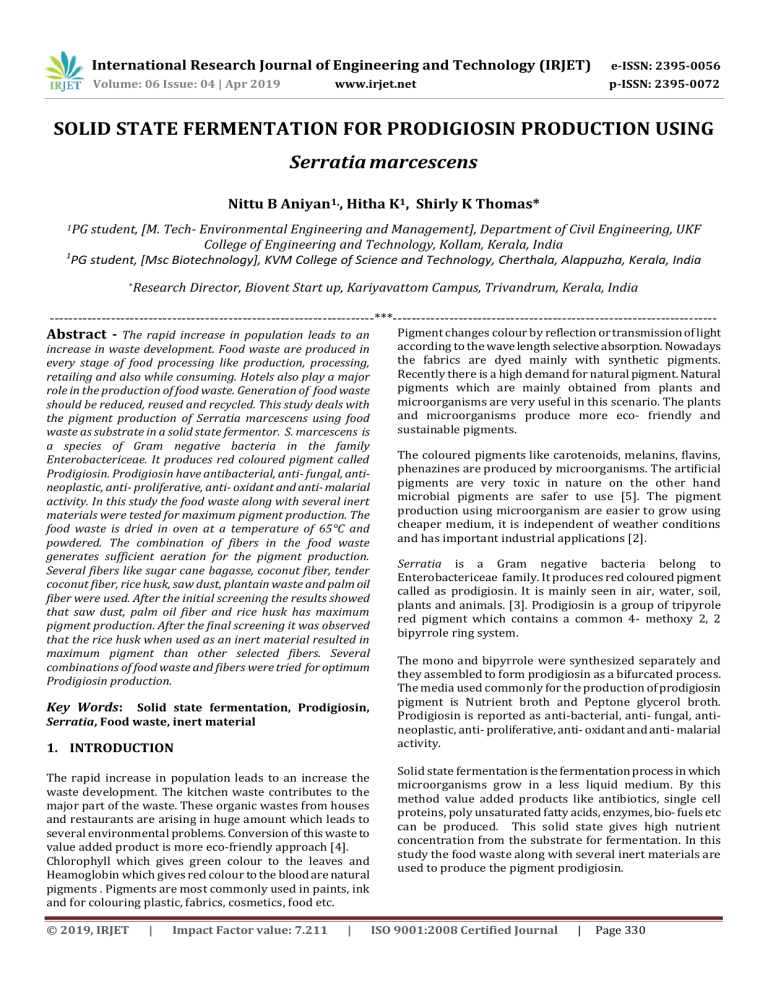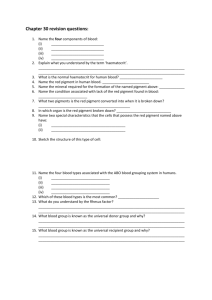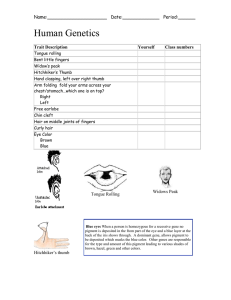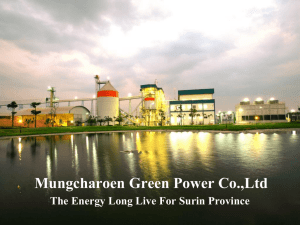Prodigiosin Production via Solid State Fermentation
advertisement

International Research Journal of Engineering and Technology (IRJET) e-ISSN: 2395-0056 Volume: 06 Issue: 04 | Apr 2019 p-ISSN: 2395-0072 www.irjet.net SOLID STATE FERMENTATION FOR PRODIGIOSIN PRODUCTION USING Serratia marcescens Nittu B Aniyan1,, Hitha K1, Shirly K Thomas* 1PG student, [M. Tech- Environmental Engineering and Management], Department of Civil Engineering, UKF College of Engineering and Technology, Kollam, Kerala, India 1 PG student, [Msc Biotechnology], KVM College of Science and Technology, Cherthala, Alappuzha, Kerala, India *Research Director, Biovent Start up, Kariyavattom Campus, Trivandrum, Kerala, India ---------------------------------------------------------------------***--------------------------------------------------------------------- Abstract - The rapid increase in population leads to an increase in waste development. Food waste are produced in every stage of food processing like production, processing, retailing and also while consuming. Hotels also play a major role in the production of food waste. Generation of food waste should be reduced, reused and recycled. This study deals with the pigment production of Serratia marcescens using food waste as substrate in a solid state fermentor. S. marcescens is a species of Gram negative bacteria in the family Enterobactericeae. It produces red coloured pigment called Prodigiosin. Prodigiosin have antibacterial, anti- fungal, antineoplastic, anti- proliferative, anti- oxidant and anti- malarial activity. In this study the food waste along with several inert materials were tested for maximum pigment production. The food waste is dried in oven at a temperature of 65°C and powdered. The combination of fibers in the food waste generates sufficient aeration for the pigment production. Several fibers like sugar cane bagasse, coconut fiber, tender coconut fiber, rice husk, saw dust, plantain waste and palm oil fiber were used. After the initial screening the results showed that saw dust, palm oil fiber and rice husk has maximum pigment production. After the final screening it was observed that the rice husk when used as an inert material resulted in maximum pigment than other selected fibers. Several combinations of food waste and fibers were tried for optimum Prodigiosin production. Key Words: Solid state fermentation, Prodigiosin, Serratia, Food waste, inert material 1. INTRODUCTION The rapid increase in population leads to an increase the waste development. The kitchen waste contributes to the major part of the waste. These organic wastes from houses and restaurants are arising in huge amount which leads to several environmental problems. Conversion of this waste to value added product is more eco-friendly approach [4]. Chlorophyll which gives green colour to the leaves and Heamoglobin which gives red colour to the blood are natural pigments . Pigments are most commonly used in paints, ink and for colouring plastic, fabrics, cosmetics, food etc. © 2019, IRJET | Impact Factor value: 7.211 | Pigment changes colour by reflection or transmission of light according to the wave length selective absorption. Nowadays the fabrics are dyed mainly with synthetic pigments. Recently there is a high demand for natural pigment. Natural pigments which are mainly obtained from plants and microorganisms are very useful in this scenario. The plants and microorganisms produce more eco- friendly and sustainable pigments. The coloured pigments like carotenoids, melanins, flavins, phenazines are produced by microorganisms. The artificial pigments are very toxic in nature on the other hand microbial pigments are safer to use [5]. The pigment production using microorganism are easier to grow using cheaper medium, it is independent of weather conditions and has important industrial applications [2]. Serratia is a Gram negative bacteria belong to Enterobactericeae family. It produces red coloured pigment called as prodigiosin. It is mainly seen in air, water, soil, plants and animals. [3]. Prodigiosin is a group of tripyrole red pigment which contains a common 4- methoxy 2, 2 bipyrrole ring system. The mono and bipyrrole were synthesized separately and they assembled to form prodigiosin as a bifurcated process. The media used commonly for the production of prodigiosin pigment is Nutrient broth and Peptone glycerol broth. Prodigiosin is reported as anti-bacterial, anti- fungal, antineoplastic, anti- proliferative, anti- oxidant and anti- malarial activity. Solid state fermentation is the fermentation process in which microorganisms grow in a less liquid medium. By this method value added products like antibiotics, single cell proteins, poly unsaturated fatty acids, enzymes, bio- fuels etc can be produced. This solid state gives high nutrient concentration from the substrate for fermentation. In this study the food waste along with several inert materials are used to produce the pigment prodigiosin. ISO 9001:2008 Certified Journal | Page 330 International Research Journal of Engineering and Technology (IRJET) e-ISSN: 2395-0056 Volume: 06 Issue: 04 | Apr 2019 p-ISSN: 2395-0072 www.irjet.net 2. MATERIALS AND METHODS 2.4 Optimization of food waste and rice husk for incubation time 2.1 Sample Collection Vegetarian and non- vegetarian foods waste was collected from twenty three different places like hotels, bakeries and households. The waste was dried in the oven at a temperature range of 65° C to 80° C and powdered. The powdered samples were combined together to make a representative sample (A), by weighing equal amount of different food waste samples collected. Solid waste fermentation was carried out along with different fibers (as inert material) such as Sugarcane bagasse, Rice husk, Plantain fiber, Palm oil fiber, Tender coconut fiber, Coconut fiber and Saw dust. Sugarcane bagasse was obtained from the juice shop, Rice husk obtained from the Rice factory. Plantain fiber was obtained from the agricultural waste. Palm oil fiber was obtained from Palm oil industry at Anchal, Kollam. Tender coconut fiber and coconut fiber were obtained from the street juice shops. The fibers were collected, dried in sunlight and crushed to produce the solid waste sample. 2.2 Inoculum prepration Serratia marcescens for the pigment production was obtained from Biovent, Department of Biotechnology, Karyavattom Campus, Thiruvananthapuram. Nutrient agar slants was used for the growth and regular maintenance of Serratia. The bacteria was inoculated to the Nutrient broth and kept for 24 hours and was used as the inoculum for Prodigiosin production. 2.3 Screening of Fibers with Food waste The combined food waste sample (A) was mixed with selected fibers as given in Table-1. The sample for initial screening was taken as 10g of A, 4g of each fibers and 20ml of distilled water [1]. The pH was adjusted to 8 and autoclaved. lml of the 24hr inoculum was added to each flask, tapped well and kept in dark for 72 hours at 28°C [1]. Table- 1: Food waste: Fiber Combinations used for Initial Screening Food Waste A A A A A A A © 2019, IRJET Fiber Coconut fiber Palm oil Plantain fiber Rice husk Saw dust Sugarcane bagasse Tender coconut fiber | Food waste: Fiber Ac Apl Apf Ar Asd As Atc Impact Factor value: 7.211 | For the optimization of incubation time, 2.5 g of food waste, 1g of rice husk and 5ml of distilled water were added to different conical flasks and the pH was adjusted to 8, autoclaved. 250 µl of the inoculum was added to each flask and then kept in dark at 28°C. The samples were duplicated and different incubation intervals like 24 hours, 48 hours, 72 hours and 96 hours were studied.After 24, 48, 72 and 96 hours of incubation 22.5 ml of acidified methanol was added to each flask and was shaken in a rotary shaker [New Brunswick scientific classic series] for about one hour. The samples were then kept for for 15 minutes and was then filtered through Whatsman filter paper 110mm and the supernatant was collected which was further centrifuged [Centrifuge 5804 R] at 10,000 rpm for 10 minutes. The pigment was extracted and O.D was measured at 532nm using Thermo Scientific Multiskan Go. 2.5 Optimization of Food waste and Rice husk for pH 2.5g food waste, 1 g rice husk and 5 ml of distilled water was added to 100ml conical flasks and each set in duplicate was adjusted at various pH like 6, 7, 8 and 9 . Inoculum size used was 250 µl. Incubation time was 96 hrs and the temperature was 28° C. After incubation the pigment was extracted and O.D was read at 532 nm as mentioned above. 2.6 Optimization of Food waste and Rice husk for Inoculum size 2.5g food waste, 1 g fiber, 5 ml of distilled water was added to 100 ml conical flask the pH was adjusted to 7 and it was autoclaved. The inoculums size was optimized by adding various percentage of inoculum as shown in Table-2. The incubation temperature was 28° C, incubation time was 96 hrs. Pigment was extracted and O.D was taken at 532 nm as mentioned above. Table- 2: Inoculum Size taken for Optimization Inoculum size (%) 1 2 3 4 5 6 7 8 9 10 12 14 Inoculum Size (µl) 25 50 75 100 125 150 175 200 225 250 300 350 ISO 9001:2008 Certified Journal | Page 331 International Research Journal of Engineering and Technology (IRJET) e-ISSN: 2395-0056 Volume: 06 Issue: 04 | Apr 2019 p-ISSN: 2395-0072 www.irjet.net 2.7 Optimization of Food waste and Rice husk for Moisture content To 2.5g of food waste and 1g fiber different percentages of moisture was adjusted to as given in Table 3. pH was set at 7 and the medium was autoclaved. The inoculum size was 25µl, the incubation time was 96 hrs and the temperature was 28°C. Pigment was extracted and O.D was taken at 532 nm as mentioned above. Table -3: Moisture Content Used for Optimization Study Moisture content (%) 160 200 240 280 320 Moisture content(ml) 4 5 6 7 8 and Rice husk. Sugarcane fiber also produced very less pigment. Tender coconut fiber and coconut fiber has no relevant pigment production. The inert material selected for further work after the initial screening was rice husk. Table- 4: Categorization of Food Waste: Fiber Combinations Based on Pigment Production [+++] Ar Asd [++] Apf Apl [+] As --- [0] Ac At Where, [+++]= Dark red, high pigment production, [++]= Pink colour, less pigment production, [+] = pale pink, pigment production is very less. 3.2 Optimization of Food waste and Rice husk for Incubation time 2.8 Optimization of Food waste and Rice husk for Carbon Source The moisture content of the media was taken as 240% from previous study and was added to 2.5g of food waste and 1 g fiber. Carbon source used for optimization were 0.5 µl of Castor oil, Sunflower oil, Coconut oil, Palm oil and Gingelly oil. These were added to different flask in duplicate. The pH was set at 7and was autoclaved. The inoculums size used was 25µl and the temperature was 28°C. After 96 hours of incubation pigment was extracted and O.D was taken at 532 nm as mentioned above. 96 hours of incubation period showed the maximum Prodigiosin production of 4.69mg/ml as given in Table5 and Chart-1. Table- 5: Optimization of Incubation Time Incubation time (in hours) 24 48 72 96 Prodigiosin mg/ml 0.811 2.81 3.96 4.69 2.9 Optimization of Food Waste and Rice husk for Nitrogen Source Sunflower oil was selected as the best carbon source and was added to the previously optimized media. Nitrogen source was optimized by adding 0.5g of Yeast, Peptone, Beef extract Rastrigella fish waste, Sardine fish waste and combination of Sardine and Rastrigella fish waste. The temperature kept was 28°. After 96 hours of incubation pigment was extracted and O.D was taken at 532 nm as mentioned above. 3. RESULTS AND DISCUSSIONS 3.1 Screening of Fibers with Food waste Chart -1: Optimization of Incubation Time The result obtained after initial screening of food waste: fiber combinations are given in Table-4. From the initial screening based on visual appearance it was found that rice husk and saw dust combination with food waste sample produce more pigment than the other combinations. Plantain fiber and Palm oil fiber combinations produce less Prodigiosin pigment than food waste sample with Saw dust © 2019, IRJET | Impact Factor value: 7.211 | 3.3 Optimization of Food waste and Rice husk for pH The optimization study at different pH like 6, 7, 8 and 9 showed that the maximum pigment production was at the pH 7 with a Prodigiosin concentration of 8.08 mg/ml as given in Table-6 and Chart-2. ISO 9001:2008 Certified Journal | Page 332 International Research Journal of Engineering and Technology (IRJET) e-ISSN: 2395-0056 Volume: 06 Issue: 04 | Apr 2019 p-ISSN: 2395-0072 www.irjet.net Table- 6: Optimization of pH pH 6 7 8 9 Prodigiosin mg/ml 5.09 8.08 6.18 7.43 Chart-3: Optimization of Inoculum Size 3.5 Optimization of food waste and rice husk for moisture content Chart-2: Optimization of Food waste and Rice husk for pH 3.4 Optimization of Food waste and Rice husk for Inoculum size The maximum pigment production was obtained at an inoculums size of 1 % (25µl) with a prodigiosin content of 6.00 mg/ml and was selected for further work. The results was given in Table-7 and Chart-3. Table-7: Optimization of Inoculum Size Inoculum size (%) 1 Inoculum size(ml) 25 Prodigiosin mg/ml 6.00 2 50 2.63 3 75 5.86 4 100 5.07 5 125 4.43 6 150 4.38 7 175 4.04 8 200 4.33 9 225 3.52 10 250 3.22 12 300 2.94 14 350 3.90 The maximum pigment production of 8.18 mg/ml was obtained at moisture content of 240% as given in Table-8 and Chart-4. Table-8: Optimization of Moisture Content Moisture content (%) 160 200 240 280 320 Moisture content(ml) 4 5 6 7 8 Prodigiosin mg/ml 1.67 4.29 8.18 5.07 5.10 Prodigiosin Con.mg/ml 9 8 7 6 5 4 3 2 1 0 160 200 240 280 % Moisture Chart-4: Optimization for Moisture Content © 2019, IRJET | Impact Factor value: 7.211 | ISO 9001:2008 Certified Journal | Page 333 320 International Research Journal of Engineering and Technology (IRJET) e-ISSN: 2395-0056 Volume: 06 Issue: 04 | Apr 2019 p-ISSN: 2395-0072 www.irjet.net 3.7 Optimization of Food waste and Rice husk for Carbon source The maximum pigment production of 7 mg/ml was obtained by the addition of Sunflower oil as carbon source as shown in table-9 and Chart-5. Table-9: Optimization of carbon source Carbon Sources Control Coconut oil Castor oil Palm oil Sunflower oil In this study the maximum pigment production was obtained without the addition of any nitrogen source as given in Table-10 and Chart-6. It was observed that even though the optimization of various parameters favored the production of the prodigiosin the overall production rate was decreased after few months. This may be due to the reduction in the shelf life of the powdered food waste material and this aspect need to be studied before further optimization. Impact Factor value: 7.211 1 3 4 5 6 7 8 3.8 Optimization of Food waste and Rice husk for Nitrogen source | Sl.No. 2 Prodigiosin mg/ml 6.55 5.31 4.64 5.20 7.00 Chart-5: Optimization of Food waste and Rice husk for Carbon source © 2019, IRJET Table- 10: Optimization of Food waste and Rice husk for Nitrogen source | Nitrogen Sources Control without carbon Control with carbon Beef Yeast peptone Sardine Rastrigella Combination Prodigiosin mg/ml 7.89 7.12 2.57 1.01 1.40 5.39 4.80 5.54 Chart-6: Optimization of food waste and rice husk for nitrogen source In this work, several fibers were tested for the prodigiosin production and found out that rice husk was the best inert material favoring the Prodigiosin production when compared with other fibers. Several parameters were optimized and the maximum pigment production was observed at an incubation time of 96 hours, pH of 7, inoculum size of 25µl, moisture content of 6ml and by adding Sunflower oil as the carbon source. The addition of excess nitrogen source does not improve pigment production in this experimental setup. In another study the addition of nitrogen litters the production of the pigment [1]. The addition of carbon sources increased the pigment production, but excess addition resulted in the reduction of the pigment in a similar study[1]. In another work palm oil when used as a source of carbon showed highest pigment production [3]. There are several other parameters like temperature, agitation speed, amino acids that favors the ISO 9001:2008 Certified Journal | Page 334 International Research Journal of Engineering and Technology (IRJET) e-ISSN: 2395-0056 Volume: 06 Issue: 04 | Apr 2019 p-ISSN: 2395-0072 www.irjet.net pigment production. The maximum production was obtained at a temperature of 28° C and at a pH of 8 in a similar study [1], but in this study the pH 7seems to be the best. Kitchen waste itself is a rich source of carbon which and has the capability to produce prodigiosin pigment [3]. The pigment production was highest after 36 hours and the pigment production decrease after 30° C in another study [3].They observed maximum production between pH 7 and 9 [3]. Peptone used as a nitrogen source showed an increase in the pigment production in a study [3]. 4. CONCLUSIONS Solid state fermentation study of food waste and fibers is a useful approach in waste management. The prodigiosin is a medicinally important pigment which has anticancerous, antioxidant, antibacterial in nature. By this method the food waste can be converted into a useful product. The study showed that the combination of food waste with rice husk produce more pigment than saw dust, plantain waste, palm oil fiber, sugarcane fiber, coconut and tender coconut fibers. Further optimization study of food waste and rice husk need to be conduct for optimum prodigiosin. REFERENCES [1] [2] [3] [4] [5] F. Xu., S. Xia, Q. Yang, “ Startergy for obtaining inexpensive prodigiosin production by Serratia marcescens’, International Conference on chemical, biological and environmental engineering, Vol. 20, 2011, 32-36. J. U. Vora., N. K. Jain and H. A. Modi, ‘Extraction, characterization and Application studies of red pigment of halophile Serratia marcescens KHIR KM035849 isolated from Kharaghoda soil’, International Journal of pure and applied bioscience, Vol.2, 2014, 160- 168. M. H. Bharmal., N. Jahagirdar and K. Aruna ,” Study on optimization of prodigiosin produced by Serratia marcescens MSK1 isolated from air”, International journal of advanced biological research, Vol.2, 2012, 671-680. S. Xia., E. Venoy and Q. Yang, “ Kitchen waste as a novel available substrate for Prodigiosin production by Serratia marcescens”, Earth and Environmental Science, Vol. 171, 2018, 18, doi:10.1088/17551315/171/1/012037. T. Suryawanshi., V. Nair., P. Patel and A. Durve Gupta, “ Isolation of pigmented bacteria for various applications”, Biological Science, Vol.7, January.2017, 25. © 2019, IRJET | Impact Factor value: 7.211 | ISO 9001:2008 Certified Journal | Page 335



